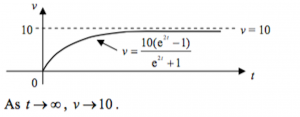All solutions here are SUGGESTED. Mr. Teng will hold no liability for any errors. Comments are entirely personal opinions.
(i)
![]()
(ii)
(a)
![]()
![]()
![]()
When ![]()
![]()
When ![]()
(b)
When ![]()
![]()
![]() Reject
Reject ![]() since
since ![]() when
when ![]()
![]()
![]()
![]()
(c)
From the graph, As ![]()
KS Comments:
(i) can be resolved easily with the MF15 formula.
(ii), students can actually plot the entire graph of t against v into the graphing calculator and calculate the v when t = 1. They should draw the graph out then. Should they do this, (c) will be solved conveniently.


[…] Question 8 […]